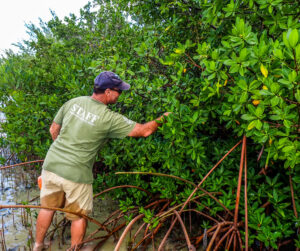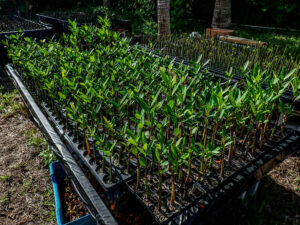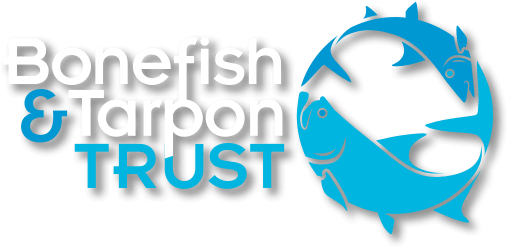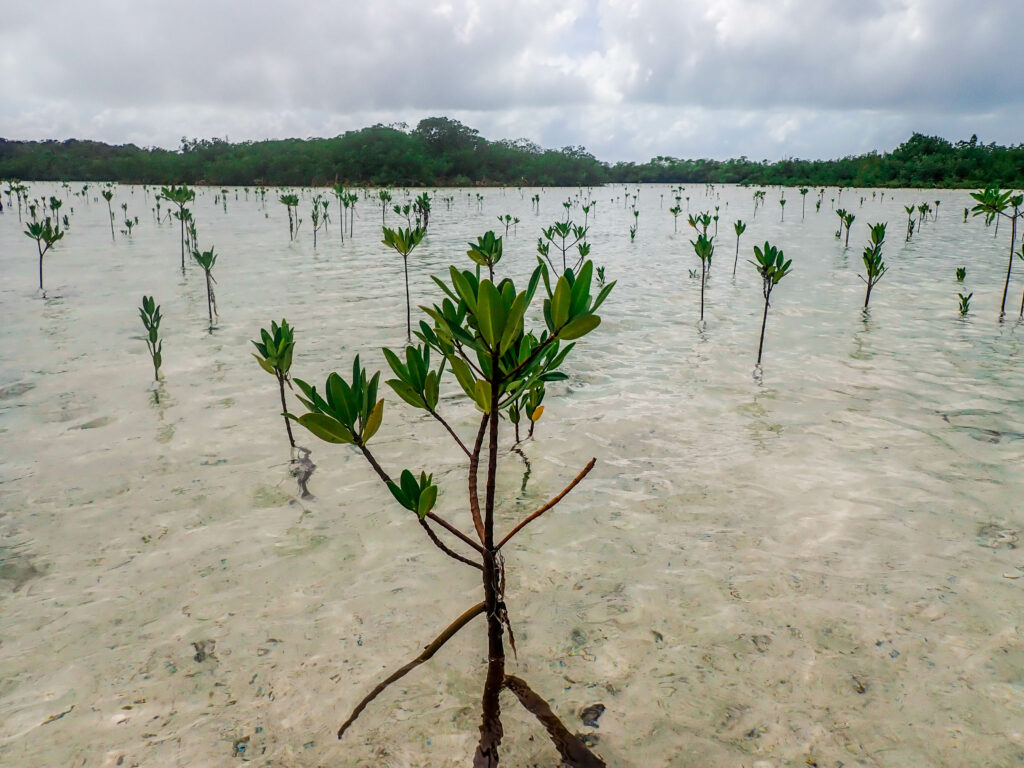Photo: Justin Lewis
Mangroves make up a critical ecosystem found in tropical and subtropical regions. They are vital not only to marine species, but also to society, as mangroves prevent coastal erosion and blunt the damaging winds of hurricanes and tropical storms. In fact, according to recent studies, just 330 square feet of mangroves can reduce incoming wave height by up to 66 percent.
In September 2019, Category 5 Hurricane Dorian, one of the most powerful storms on record, struck the northern Bahamas, destroying an estimated 74 percent of mangrove forests on Grand Bahama and 40 percent on Abaco.
In an effort to heal the mangrove forests of the Bahamas, BTT is partnering with Bahamas National Trust, Friends of the Environment in Abaco and MANG Gear to transplant up to 100,000 mangroves to enhance recovery of the mangrove ecosystems in Grand Bahama and Abaco. We recently spoke with Kyle Rossin, co-founder of MANG Gear, to learn more about the strides their company is making in mangrove restoration and protection.
What inspired you to work with mangroves?

That’s a great question; it all goes back to 2015 while I was pursuing a degree in environmental studies at FGCU (Florida Gulf Coast University). I always had a passion for the environment, and it sprang from one idea to start to create a mangrove camouflage that could contribute back to our local coastal ecosystems. That was the moment when our Buy One. Plant One.® initiative was born—planting a mangrove for every product we sell. The final piece was establishing our name, MANG, which stands for “mangroves,” and building a brand that embodies the health of coastal ecosystems.
Your website says you’re working to further decrease MANG’s environmental footprint. How are you striving to accomplish environmental sustainability as a company?
In 2020, MANG is pushing forward with some great initiatives, like our goal to get rid of all single-use plastics for our shipping process. We’ve sourced a cornstarch glassine insert and a new recycled fiber mailer we’ll be using to ship, as well as experimenting with gum tape to seal our larger boxes.
This is a step that we believe all companies should be making as we lead the path to promote more environmental good. Rethinking our shipping process is a small step in the right direction as the MANG brand continues to decrease our environmental footprint.
How do you encourage education in the field of mangrove propagation and protection?
As a company, MANG’s brand is founded on the roots of education, restoration, and of course high-quality outdoor apparel. We are passionate about educating our community through hosting nursery events at our HQ, leading planting expeditions every month to see restoration first hand, and partnering with schools to teach the next generation of Mini MANGs about coastal ecosystems.
We believe that educating people about how mangrove ecosystems are a keystone species is one of the most important aspects of growing our preservation and restoration efforts. In the digital space, social media has been a great tool to educate new audiences about the world of mangroves.
Walk us through the process of your propagation and plantings — How long do they take to plan, how many people participate, how do you put the mangroves into the ground?
Each summer, mangrove propagules and seeds begin to form on red, white and black mangroves. After developing, they drop from the trees into our waterways in an effort to find soil, take root, and propagate naturally, or “hydrologically propagate.”

Over the years, there are less and less natural habitats for mangroves to propagate on due to coastal development. So each year, we do an annual seed collection campaign (the Propagule Collection Campaign on the website) in an effort to restock and grow our local Florida nursery. Seeds and propagules that the community collects all across Florida are then planted into seed trays here at HQ where they begin their two-year journey to healthy, ready-to-plant mangroves.
By growing them up for 24 months, we dramatically increase their chance of success when planted in the wild. That is a key difference for us—we don’t just plant immature seeds and propagules, we actually take extreme care to ensure their survival rate and build truly healthy coastlines.
What role will MANG play in its partnership with Bonefish & Tarpon Trust to restore mangrove forests destroyed by Hurricane Dorian?
In order to properly restore the 170 sq/kms of mangrove forests devastated by Hurricane Dorian, MANG launched a statewide propagule collection campaign to begin producing the 100,000 mangroves needed to kick-start the restoration. Since launching in October, we’ve collected 20,000 propagules and 7,500 seedlings / small red mangroves.
Obviously, 100,000 is a ton of mangroves, and we’ll be working for many years to grow that propagule supply chain and even crate dedicated nurseries for that project. However, we’re also incredibly excited to participate in the hydrologic surveying, planting plan, education and consultation for local organizations, and the ultimate growth of all these mangroves to ensure a healthy island and habit for both people and marine life.




